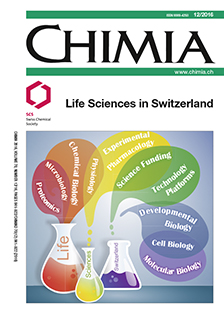Chemokines: Chemistry, Biochemistry and Biological Function
DOI:
https://doi.org/10.2533/chimia.2016.856Keywords:
Chemokines, CytokinesAbstract
The in vitro synthesis of correctly folded functional proteins remains challenging. Chemokines, which consist of only 70–100 amino acids, are accessible through solid-phase synthesis and easily fold into a thermally stable tertiary structure. From the time of their discovery in the late 1980s chemokines could therefore be synthesized using biochemical and chemical protocols for structure-function analyses and for exploring the chemokine system in vitro and in vivo. In this short overview aimed at a chemistry-oriented readership we will introduce chemokines in general, and then discuss their structure, their isolation from biological materials, as well as the different methods to produce chemokines in the laboratory and finally we will present some examples of their functions in vivo.Downloads
Published
2016-12-21
Issue
Section
Scientific Articles
License
Copyright (c) 2016 Swiss Chemical Society

This work is licensed under a Creative Commons Attribution-NonCommercial 4.0 International License.
How to Cite
[1]
D. F. Legler, M. Thelen, Chimia 2016, 70, 856, DOI: 10.2533/chimia.2016.856.







